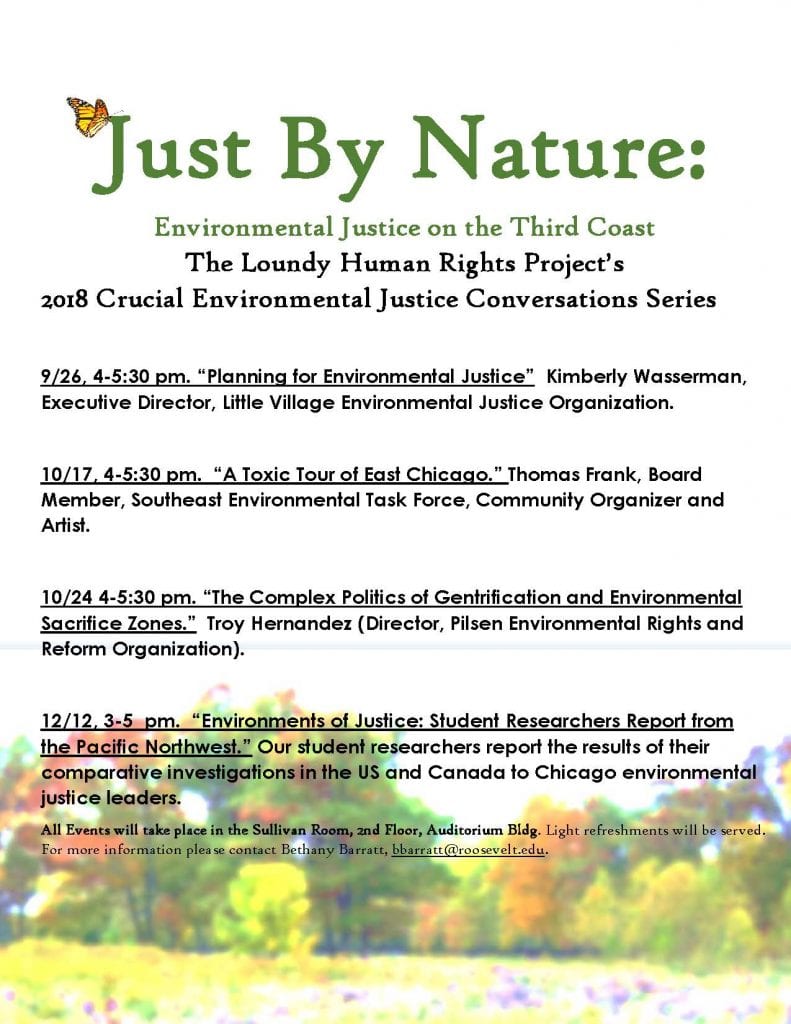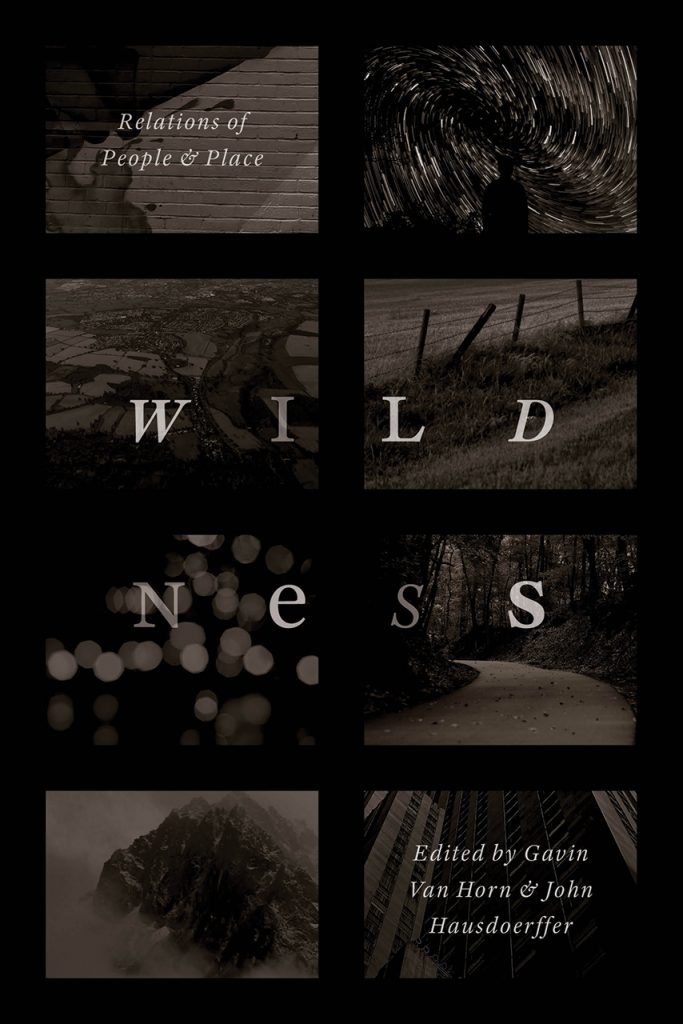I was honored to be interviewed for this Chicago Tonight special report on the current status of Bubbly Creek, aka the South Fork of the South Branch of the Chicago River. This was an effort by students in the DePaul University Center for Journalism Integrity and Excellence. Legendary local TV journalist Carol Marin came to my RU office in downtown Chicago, where we chatted about the Creek’s history and present condition while the students filmed us. Take a look, and let me know if anyone can saying “capping the sludge” better than Carol!
Category: Urban ecology
Planning for Environmental Justice: Kim Wasserman @RooseveltU, Wed 9/26
“Cultivating the Wild” Essay Reprinted in The Leopold Outlook
Warm tidings on a cold December morning: “Cultivating the Wild on Chicago’s South Side,” an essay I co-wrote about Eden Place Nature Center with Michael Howard for the book Wildness: Relations of People and Place (U. Chicago P., 2017), has been reprinted in the Fall 2017 issue of The Leopold Outlook magazine.
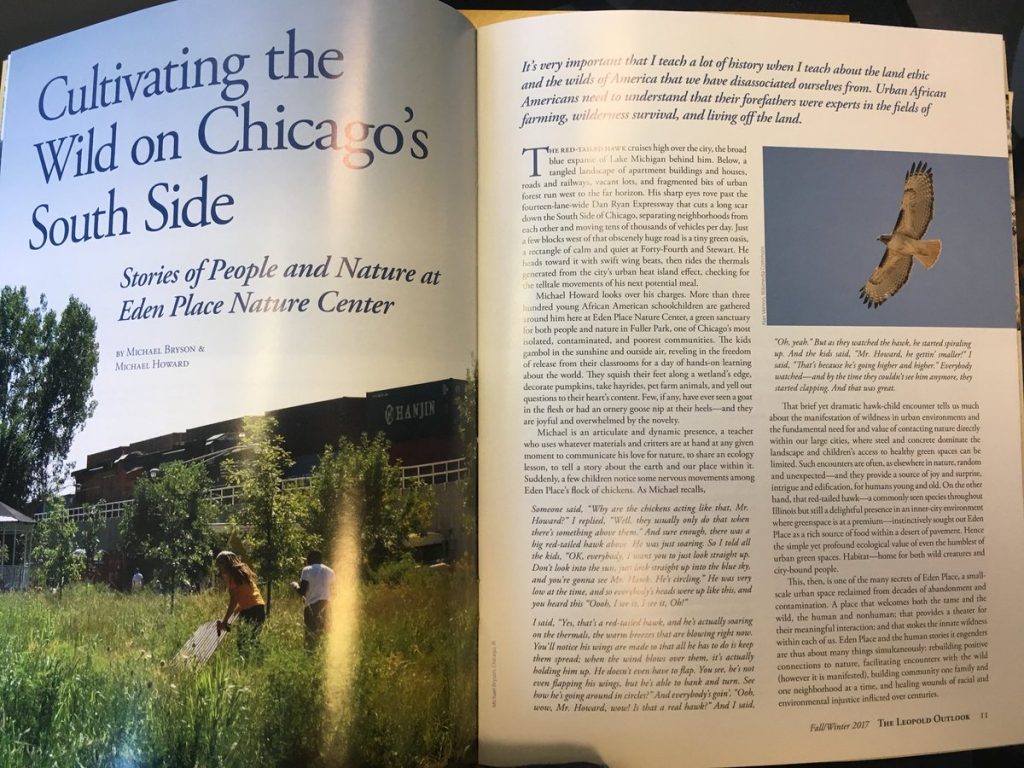
Check out the magazine’s back issues here and learn more about the Aldo Leopold Foundation’s work. And many thanks to my co-author Michael Howard as well as the co-editors of Wildness, Gavin Van Horn and John Hausdoerffer, for encouraging us to take on this project.
Oxfam Hunger Banquet Today @RooseveltU 1pm
 I’m honored to deliver a guest faculty lecture at this event today at Roosevelt University. Please come and engage in a meaningful conversation about how food insecurity is prevalent and relates to our community while you learn more about issues of hunger, sustainability and how you can help. Please register for the event here.
I’m honored to deliver a guest faculty lecture at this event today at Roosevelt University. Please come and engage in a meaningful conversation about how food insecurity is prevalent and relates to our community while you learn more about issues of hunger, sustainability and how you can help. Please register for the event here.
 Sponsored by the Black Student Union and the RU Counseling Center, the Oxfam Hunger Banquet provides a chance for us to address the severity of food insecurity and starvation as it relates to our community, and will assist in fostering a community of care that will allow us to join in the fight against inequality, injustice, and oppression. Oxfam is a global organization working to end the injustice of poverty.
Sponsored by the Black Student Union and the RU Counseling Center, the Oxfam Hunger Banquet provides a chance for us to address the severity of food insecurity and starvation as it relates to our community, and will assist in fostering a community of care that will allow us to join in the fight against inequality, injustice, and oppression. Oxfam is a global organization working to end the injustice of poverty.
Scenes from the Rooftop on RU’s Service Day 2017
This past Thursday, September 14th, folks from all corners of the university headed up to the 5th floor Rooftop Garden at RU’s Wabash Building in Chicago to get some fresh air, pull weeds, enrich the planting beds, harvest herbs, and sow winter rye and butterfly weed for the coming cold season. We also enjoyed some fine views of the downtown Chicago skyline, a definite benefit of working at altitude in what one volunteer called “Roosevelt’s very own Secret Garden.”
As part of Service Day, which concluded the 2nd annual American Dream Reconsidered Conference, students, alumni, faculty, staff, and administrators all pitched in on this effort — plus we were graced with a visit from President Ali, who took great delight in sowing the first seeds of our winter rye crop.
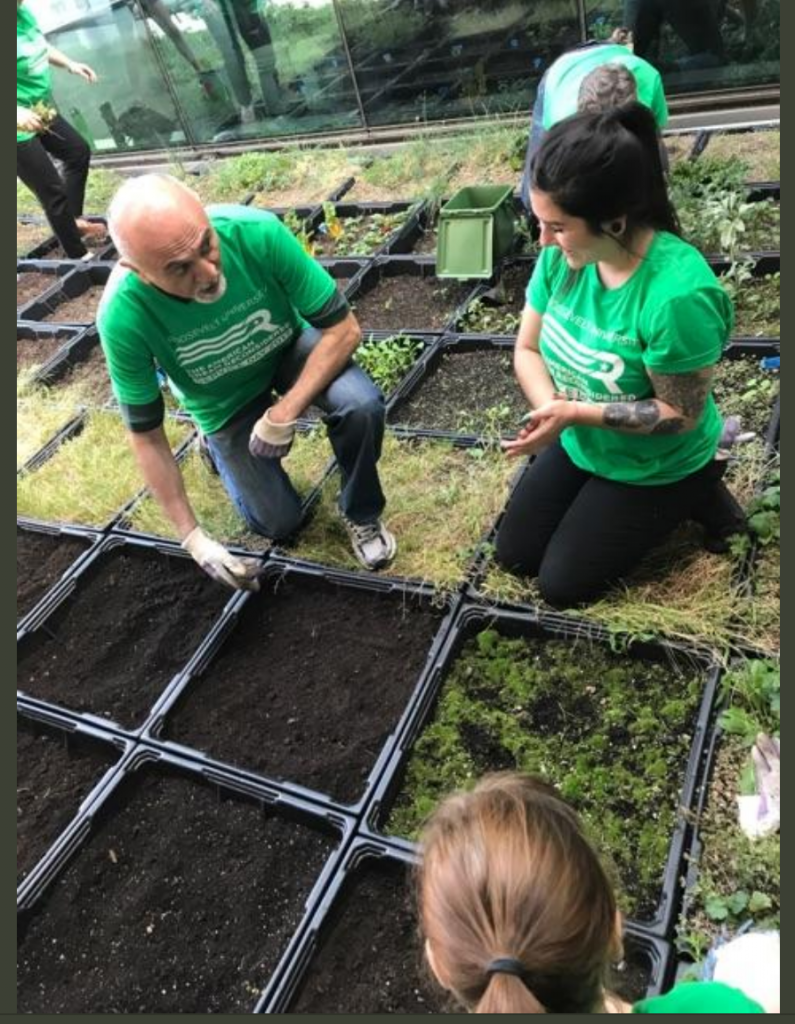
Special thanks to the 4 teams of volunteers who worked throughout the day; to RU Dining Services, which donated snacks for the volunteers (muffins flavored with chives from the garden and salad greens likewise harvested from these plots); and SUST alumni Diana Ramirez and Moses Viveros (both BA ’17), who worked this summer as Rooftop Gardeners here at the Chicago Campus, and who organized/led this volunteer effort. Thank you all!
Below are image versions of the two-page informational handout (see this pdf) on the importance of sustainability at Roosevelt Moses created and which we distributed on Service Day. Please share widely!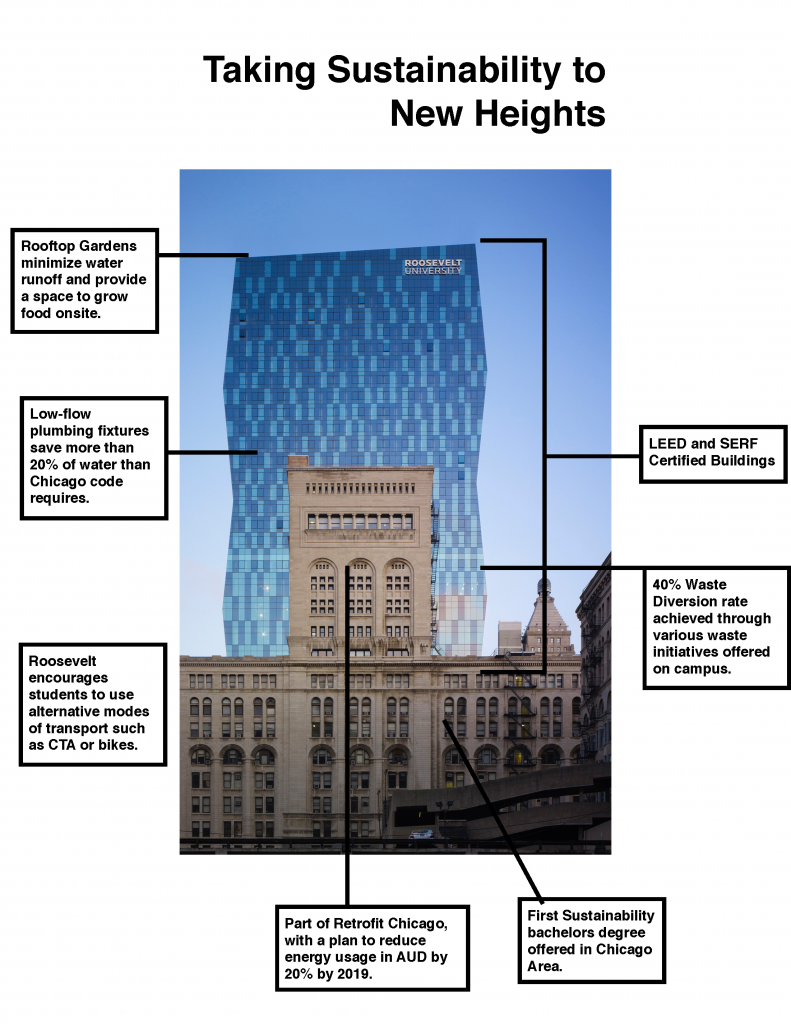

Save the Fen at Joliet Junior College: An Open Letter
This is an open letter I wrote recently to the leadership of Joliet Junior College in my hometown of Joliet, Illinois. The issue at hand is a future road extension, proposed by a mall developer, that would bisect the protected natural areas of the JJC Campus and compromise a rare type of Illinois wetland. The proposed roadway has galvanized support for the JJC Fen and associated natural areas on campus and in the Joliet community, as the College’s Board of Trustees debates how to proceed.
13 June 2017
Dear President Judy Mitchell and Board Chairman Bob Wunderlich –
I write to you today as a citizen of Joliet, a longtime environmental educator, and the son and grandson of JJC graduates. My overall message to you and your colleagues on the JJC Board of Trustees is simple: I strongly support the view of the JJC Natural Areas Committee and numerous faculty, students, alumni, and community members that the JJC Fen and associated open/natural areas must be protected from the proposed road extension by Cullinan Properties.
Since its settlement began in the late 18th and early 19th centuries, Illinois has lost over 90% of its natural wetlands to agricultural and urban development. In the meantime, it has built what must be millions of miles of roads, many of which are deteriorated and no longer in use. In short: we have enough roads. We cannot afford to lose yet more high quality wetlands.
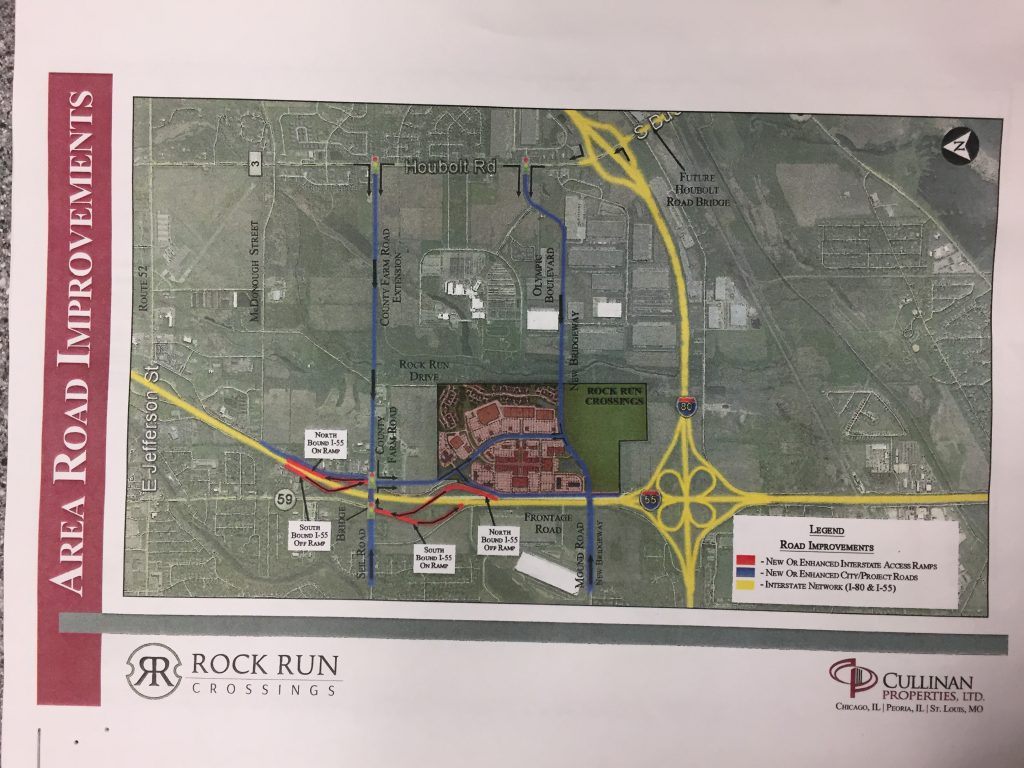
As the above map illustrates, the proposed County Road Extension is neither the shortest nor the most convenient traffic route from the adjacent I-55 and I-80 interstates to Cullinan’s proposed “mixed-use lifestyle center” — yet even if it were, it would not be the best route. As the great writer, ecologist, and conservationist Aldo Leopold famously wrote in his 1949 book A Sand County Almanac, “A thing is right when it tends to preserve the integrity, stability, and beauty of the biotic community. It is wrong when it tends otherwise” (pp. 224-5).
The importance of JJC’s high quality open spaces, biodiversity, water quality, landscape aesthetics, and overall campus sustainability far outweigh the supposed advantages of this road extension, which serves no other purpose than to direct traffic to a shopping center that could otherwise take several other perfectly viable alternative routes that are faster and more direct.
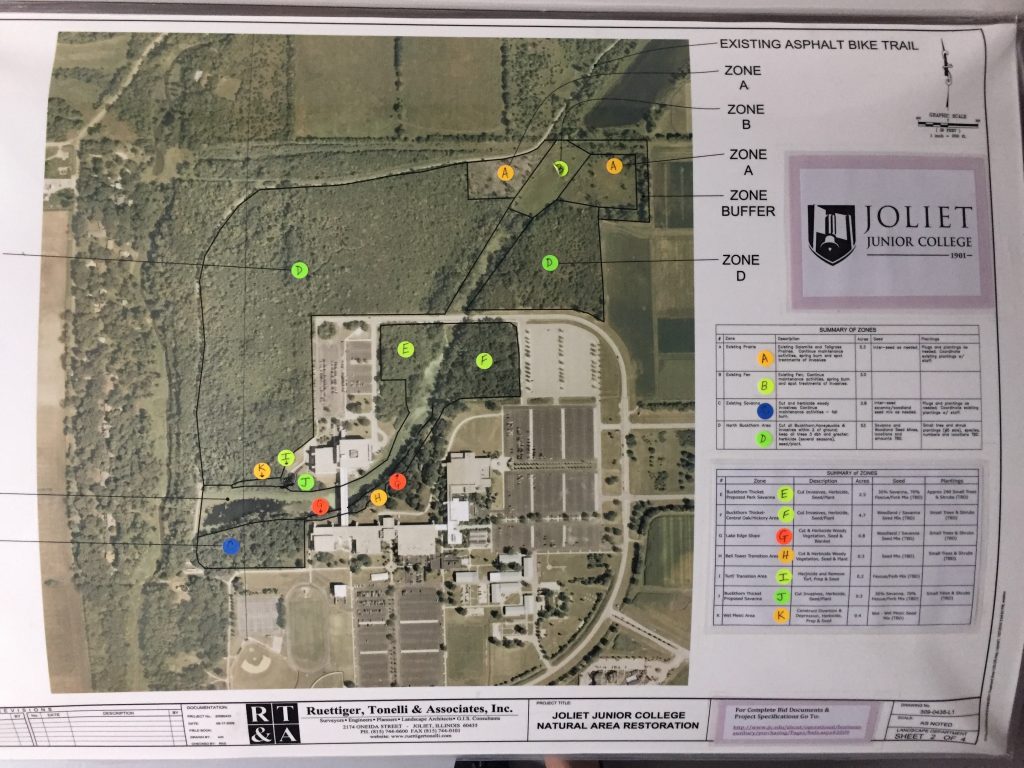
As the College mulls over the tempting overtures of Cullinan Properties and decides whether to protect this ecologically and educationally valuable ecosystem, or to allow its fragmentation and ultimate degradation, I urge you and your colleagues to take a long view of the matter. A perspective informed by environmental sustainability inspires us to ask careful questions about the road, the character of the campus, and the institutional mission — questions that relate not just to the issues of the day, but those decades into the future.
We now live in a world of rapid urbanization, climate change, and accelerating species extinction. A century from now, I highly doubt that the leaders, faculty, students, and alumni of JJC will look favorably upon a decision in 2017 to disturb and degrade its coveted and protected natural areas with a road built exclusively to service a single shopping center. In fact, given the economic vagaries that occur over a mere 20-30 years, let alone a century, it’s questionable said development will even be operating that far into the future. (The example of the Jefferson Square Mall, built in 1975 with great fanfare and now vaporized from the landscape a mere 40 years later, comes to mind, though there are many others one could cite.)
However, I do think that the future stewards of America’s first and oldest community college (founded 1901) would be rightly proud in the year 2117 that its leaders in the present day chose to maintain the ecological and aesthetic integrity of the campus ecosystem by conserving its tranquil and species-rich open space, protecting the water quality of its beautiful lake and stream, and ensuring the opportunities of generations of students to study field-based biology and ecology in the extraordinary “living classroom” provided by one of Illinois’ most rare and endangered wetlands, a fen.
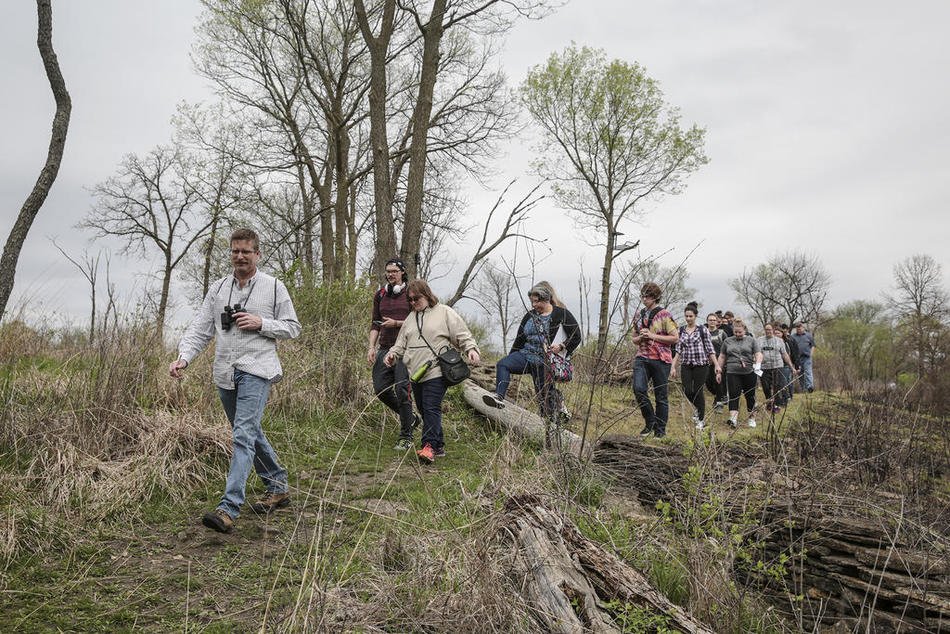
As a graduate of the local public schools (JT West class of 1985), a current resident of Joliet, and now a professor of sustainability studies at Roosevelt University in Chicago, I have developed a close relationship over the past 12 years with many students and faculty at JJC. I can attest from my vantage point in the regional higher ed community that JJC’s commitment to environmental sustainability – embodied in its native woodland, prairie, and wetland ecosystems; its 1998 Natural Areas Resolution; its LEED-Platinum greenhouse facility and widely-praised arboretum; its progressive academic programming; and its campus sustainability leadership – is the envy of many colleges and universities in the Chicagoland region.
Consequently, harming the fundamental character of the campus’ rare and biodiverse ecosystems would not just diminish the quality of the College’s outdoor learning laboratories; it would also directly contradict JJC’s professed commitment to sustainability and potentially erode its hard-won reputation among its institutional peers.
As a local citizen who cares deeply about and greatly appreciates JJC’s remarkable history and unique educational mission, I ask that you heed the recommendations of the Natural Areas Committee and protect said Natural Areas, including the fen, from any present or future road development.
Yours sincerely,
Mike Bryson
Resident of Joliet, IL
Professor & Director of Sustainability Studies, Roosevelt University
Wildness: Relations of People and Place
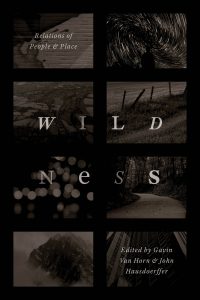 This March saw the publication of the new book Wildness: Relations of People and Place, edited by Gavin Van Horn and John Hausdoerffer (Univ. of Chicago Press, 2017), an environmental humanities project sponsored by the Center for Humans and Nature. Part 3 of the book, entitled Urban Wild, includes an essay I co-wrote with Mr. Michael Howard, a Chicago community leader, conservationist, and environmental educator: “Cultivating the Wild on Chicago’s South Side: Stories of People and Nature at Eden Place Nature Center.”
This March saw the publication of the new book Wildness: Relations of People and Place, edited by Gavin Van Horn and John Hausdoerffer (Univ. of Chicago Press, 2017), an environmental humanities project sponsored by the Center for Humans and Nature. Part 3 of the book, entitled Urban Wild, includes an essay I co-wrote with Mr. Michael Howard, a Chicago community leader, conservationist, and environmental educator: “Cultivating the Wild on Chicago’s South Side: Stories of People and Nature at Eden Place Nature Center.”
I’m fortunate to have been part of this wonderful project, which began with a writer’s retreat in September of 2014 in Crested Butte, CO, featuring writing workshops by the award-winning scientist and nature writer, Robert Michael Pyle (whose own essay follows a poem by none other than the legendary Gary Snyder). My interviews and writing sessions with Mr. Howard at Eden Place in 2015, and the three semesters I’ve worked there with my students each fall since 2014, have made getting a sense of this special place in the world an immensely gratifying experience. Thanks to Gavin and John for shepherding this project through its publication!
From the book’s promo page on the Univ. of Chicago Press website:
Whether referring to a place, a nonhuman animal or plant, or a state of mind, wild indicates autonomy and agency, a will to be, a unique expression of life. Yet two contrasting ideas about wild nature permeate contemporary discussions: either that nature is most wild in the absence of a defiling human presence, or that nature is completely humanized and nothing is truly wild.
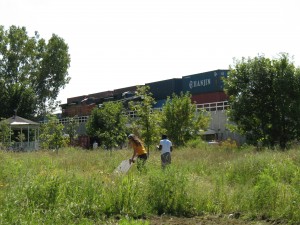
This book charts a different path. Exploring how people can become attuned to the wild community of life and also contribute to the well-being of the wild places in which we live, work, and play, Wildness brings together esteemed authors from a variety of landscapes, cultures, and backgrounds to share their stories about the interdependence of everyday human lifeways and wildness. As they show, far from being an all or nothing proposition, wildness exists in variations and degrees that range from cultivated soils to multigenerational forests to sunflowers pushing through cracks in a city alley. Spanning diverse geographies, these essays celebrate the continuum of wildness, revealing the many ways in which human communities can nurture, adapt to, and thrive alongside their wild nonhuman kin.
From the contoured lands of Wisconsin’s Driftless region to remote Alaska, from the amazing adaptations of animals and plants living in the concrete jungle to indigenous lands and harvest ceremonies, from backyards to reclaimed urban industrial sites, from microcosms to bioregions and atmospheres, manifestations of wildness are everywhere. With this book, we gain insight into what wildness is and could be, as well as how it might be recovered in our lives—and with it, how we might unearth a more profound, wilder understanding of what it means to be human.
Visit the Center for Humans and Nature’s Wildness website for upcoming events and a series of related short films, including one of Michael Howard and Michael Bryson talking about Eden Place.
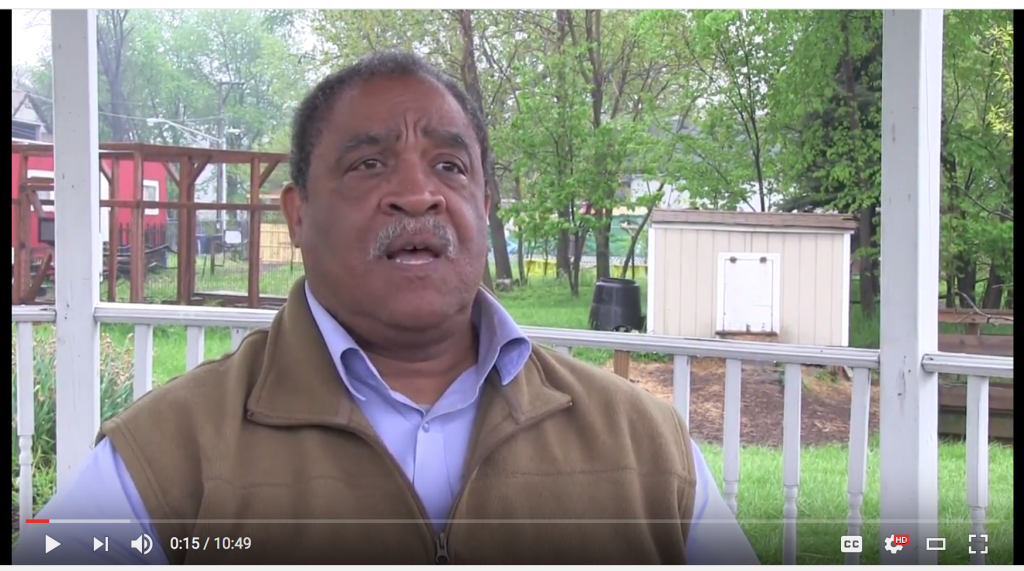 Click on the image above to go to the video interview of Michael Howard (pictured) and Michael Bryson at Eden Place Nature Center.
Click on the image above to go to the video interview of Michael Howard (pictured) and Michael Bryson at Eden Place Nature Center.
Introducing “Rooftop: Second Nature” — Remarks at the Opening Reception, 9 Feb. 2017
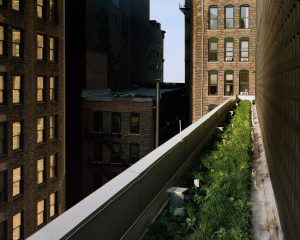
Nature within the urban landscape is simultaneously close at hand and hidden from view — a paradox of proximal obscurity. Yet its myriad forms are as diverse in kind as their human denizens. City parks, urban farms, back yards, forest preserves, vacant lots, and green rooftops — all these and more comprise the spaces of urban nature.
Despite the ubiquity and diversity of urban nature, it remains largely invisible to and thus unappreciated by many city dwellers. We are much more likely to assume nature exists “out there,” away from our cities and suburbs — especially in remote places characterized by few people and sublime landforms. An implicit corollary to that is that the city is unnatural.
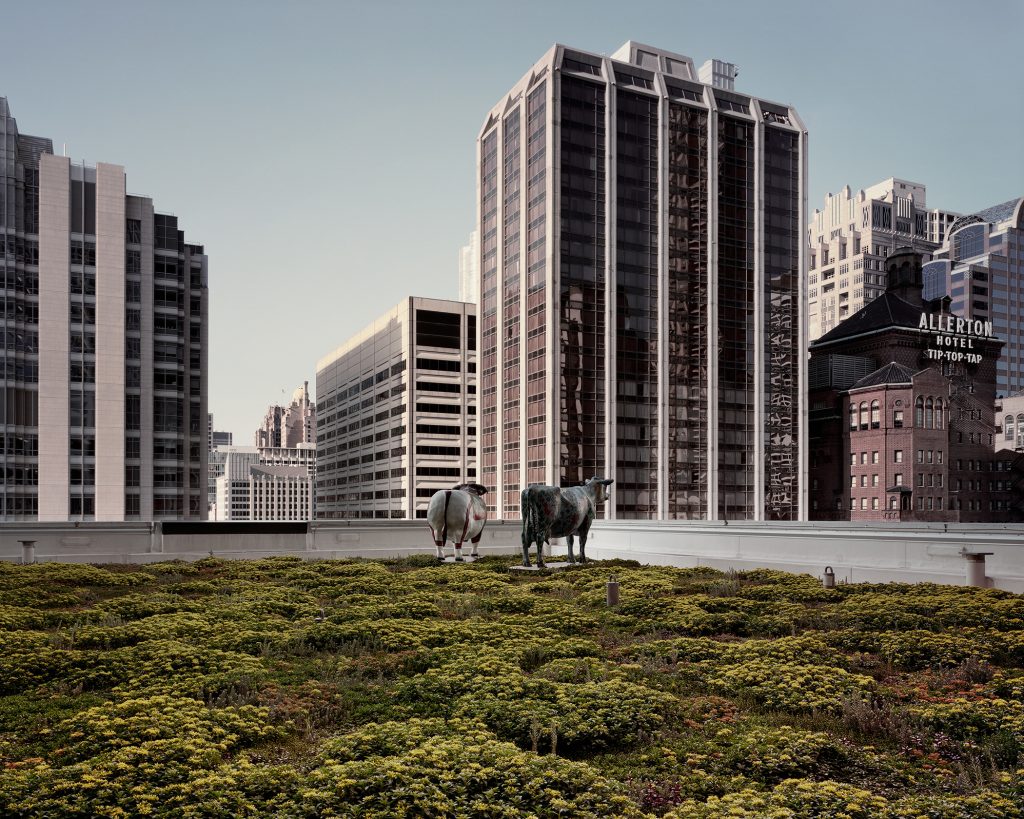
Yet the recent coinage of the seemingly oxymoronic phrase urban wilderness signals that we have begun to re-envision the role of nature within metropolitan landscapes. This nature is almost always hybrid in character, a product of human design and action even when appearing “natural” in outward form. Consider our location right here, along the southwestern rim of Lake Michigan — where the surveyor’s grid was laid down upon the marshy prairie, a river’s current audaciously reversed, and lakefront parkland perched atop thousands of tons of landfill.
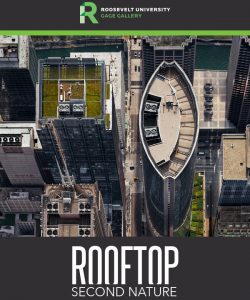 The intersections of the made and the natural can be apprehended in such settings . . . if one observes carefully, knows where to look, and possesses a spirit of exploration. The dramatic roofscapes by Brad Temkin in Rooftop: Second Nature are striking visual compositions that reveal the city from a different and unfamiliar angle, as well as information-rich object lessons in how green infrastructure enhances urban sustainability.
The intersections of the made and the natural can be apprehended in such settings . . . if one observes carefully, knows where to look, and possesses a spirit of exploration. The dramatic roofscapes by Brad Temkin in Rooftop: Second Nature are striking visual compositions that reveal the city from a different and unfamiliar angle, as well as information-rich object lessons in how green infrastructure enhances urban sustainability.
More broadly, though, this exhibit speaks to the vital role played by the environmental arts and humanities in envisioning a more sustainable future for humanity as well as for the millions of fellow species on our beautiful yet vulnerable planet. Thought-provoking ideas, artwork, architecture, poetry, stories, historical accounts, theater, music, and film are necessary complements to painstaking ecological analysis and pragmatic environmental policy.
Why? Because ideas and vision matter. Compelling narratives, whether literary or visual, can animate science, challenge our use of technology, inspire policy, and change hearts and minds. Such narratives must guide our thinking to ensure that social equity and environmental justice are not trampled in the relentless pursuit of short-term profits from, say, building oil pipelines across sources of drinking water in the Great Plains; or dumping the “overburden” of mountaintops into the creeks and rivers of Appalachian coal country; or selling more Pepsi or iPhones.
Skeptics of climate change cannot be persuaded by scientific data and evidence-based policy alone — certainly not when science itself is under unprecedented attack in our society; not when environmental laws are in imminent danger of being dismantled; not when the very status of an observed and documented fact is undermined by the brazen contempt for reason and unsettling embrace of doublespeak that now constitutes the discourse of the new administration.
In such fraught and perilous times, a sustainable future can only be achieved, let alone properly envisioned, with the full participation and engagement of the environmental arts and humanities.
By showing us the “second nature” of the urban landscape in these images of green rooftops, Brad Temkin’s art not only delights and inspires with unexpected manifestations of beauty, but also implicitly challenges us to consider what “first nature” is, and what sort of relationship we want with it — one which in we are conquerors . . . or stewards.
This is a slightly edited version of a short speech I gave at the opening reception for Rooftop: Second Nature on 9 Feb 2017 at Roosevelt University’s Gage Gallery, 18 S. Michigan Ave., Chicago IL. The Gallery is open 9am-5pm weekdays and 10am-4pm Saturdays.
Photography, Sustainability, & Urban Design: “Rooftop: Second Nature” Opens 2/9 at RU’s Gage Gallery
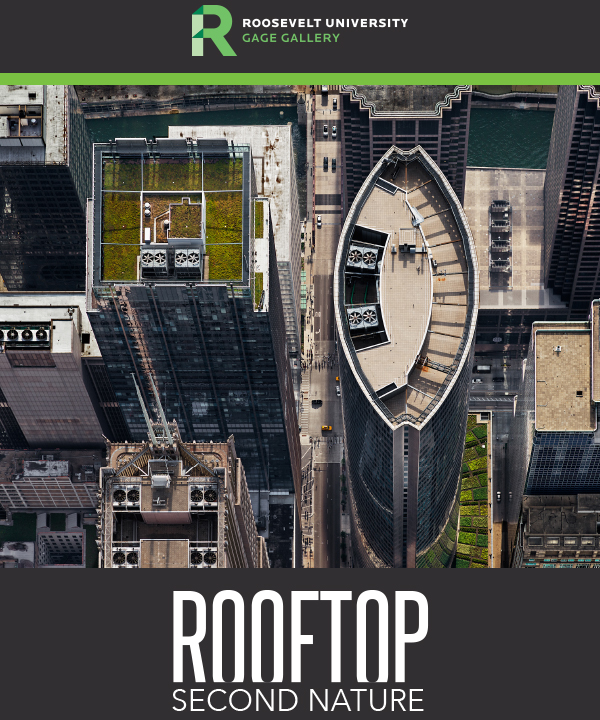 Photographs by Brad Temkin
Photographs by Brad Temkin
February 9 – May 6, 2017
Opening reception and talk by Brad Temkin
Thursday, February 9th, 5-7 p.m.
Roosevelt University’s Gage Gallery
18 S. Michigan Ave., Chicago IL
(312) 341-6458
Statement from the Artist
“Rooftop: Second Nature draws poetic attention to an important new movement to counter the heat island effect caused by city life. Green roofs reduce our carbon footprint and improve storm water control, but they do far more. They reflect the conflict of our existence, symbolizing the allure of nature in the face of our continuing urban sprawl.
“My images do more than merely document rooftop gardens. By securely situating the gardens within the steel, stone, and glass rectangularity of urban downtowns, I ask viewers to revel in their far more open patterns, colors, and connection to the sky. In this break, I see not merely beauty and dichotomy, but the framework for positive change.”
— Brad Temkin
On Urban Ecology, Green Rooftops, and the Sustainability of Cities
Exhibit Essay for Rooftop: Second Nature, Roosevelt University, Spring 2017
What does a sustainable city look like? Solar panel arrays, bike lanes along busy thoroughfares, and urban farms converted from vacant lots all come to mind; but the iconic symbol of the contemporary green metropolis is the green rooftop. Though mostly invisible to us at ground level, these living surfaces embody key chacteristics of the urban ecosystem even as they serve as sustainability badges of honor for environmentally-minded civic leaders.
The science of urban ecology demonstrates that cities are not mere technological constructions, distinct from and diametrically opposed to nature, but complex ecosystems constituted by energy flows and waste sinks, evolving communities of organisms, and habitats both natural and designed. The green rooftops that increasingly dot the skylines of 21st-century cities are engineered to serve specific ecological, economic, and/or aesthetic functions for the buildings they crown and the people who inhabit them. Such spaces are simultaneously technological and natural: well-ordered assemblages of soil, plants, and micro-organisms that soften the surfaces and round the edges of the rectilinear built environment.
Said rooftops also are prime examples of green infrastructure, a critically important element of the urban fabric. Parklands and nature preserves, wetlands and riparian zones, bioswales and rain gardens, farm lots and backyard gardens, and green rooftops — all comprise a city’s green infrastructure. These diverse physical spaces provide a myriad of ecosystem services: they conserve freshwater resources, reduce energy consumption, mitigate air and water pollution, create wildlife habitat, and enable our own physical contact with nature.
The dramatic images in Rooftop: Second Nature are striking visual compositions that reveal the city from a different and unfamiliar angle, as well as information-rich object lessons in how green infrastructure enhances urban sustainability. Within one roof’s environs, a diverse riot of native prairie plants is juxtaposed with the boxy lines of air conditioning units, while other images expand the frame beyond the rooftop’s edge to portray its larger context, such as Chicago’s street grid bisected by its namesake river.
Such visual elements evoke the entanglement of ecological cycles in which the roof participates. These living surfaces provide superior building insulation, thus reducing heating and cooling costs and, in turn, decreasing carbon emissions. Plants evapotranspire water, which cools the micro-climate of the building’s exterior, thus mitigating the urban heat island effect. Precipitation falling on these rooftops is not wasted as runoff to an energy-intensive sewer and wastewater treatment system; rather, it is captured in place, absorbed by the resident plant community, and returned to the atmosphere in a silent yet eloquent demonstration of the water cycle.
Brad Temkin’s photographs are densely layered with meaning and invite inquiry from the viewer: From what vantage point was that shot taken? What are beehives doing on a skyscraper roof? How is this largely unseen rooftop relevant to the river flowing only two blocks away? Who has access to these spaces, and what psychological benefits might accrue from exploring them? Such questions suggest the dynamic interplay between art and science within our perceptions of the sustainable city.
— Michael A. Bryson
Water Stories: Narrative, Urban Sustainability, and the Fluid Future of the Otakaro-Avon River in Christchurch, New Zealand
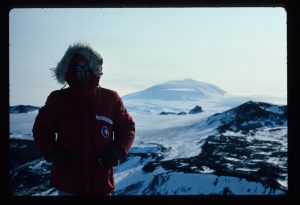
Twenty-five years ago, I had a once-in-a-lifetime opportunity to travel to Antarctica as part of a scientific research expedition from Woods Hole Oceanographic Institution. Taking a semester’s leave from my graduate studies at SUNY Stony Brook, I worked for two months as a field technician and writer-in-residence on a team researching the biogeochemistry of Lake Fryxell, a permanently frozen-over lake in Antarctica’s Dry Valleys. This extraordinary experience was memorable in many ways, including a brief three-day stopover in New Zealand, where we made our final preparations at the US Antarctic Program’s headquarters in Christchurch before flying to McMurdo Station on the Ross Ice Shelf.
 Now as a mid-career academic seeking new challenges and opportunities beyond my Midwestern home at the southern rim of the Great Lakes — and having traveled outside the US (to Canada) only twice during this time — I decided to apply for a Fulbright Scholar fellowship to explore a distant locale that has always resonated powerfully in my memory. But this time, instead of a mere fleeting taste of Christchurch and a brief fly-over of the North and South Islands, I hope to spend several months in 2018 researching, writing, and living in New Zealand, based at Lincoln University a few kilometers outside of Christchurch, in order to enrich my understanding of urban river ecosystems as well as gain a much-needed global perspective on my scholarship and teaching.
Now as a mid-career academic seeking new challenges and opportunities beyond my Midwestern home at the southern rim of the Great Lakes — and having traveled outside the US (to Canada) only twice during this time — I decided to apply for a Fulbright Scholar fellowship to explore a distant locale that has always resonated powerfully in my memory. But this time, instead of a mere fleeting taste of Christchurch and a brief fly-over of the North and South Islands, I hope to spend several months in 2018 researching, writing, and living in New Zealand, based at Lincoln University a few kilometers outside of Christchurch, in order to enrich my understanding of urban river ecosystems as well as gain a much-needed global perspective on my scholarship and teaching.
Objectives and Methodology: My proposed project focuses on the Otakaro-Avon River that flows through Christchurch, NZ, as a natural and human ecosystem undergoing stress and change. The Otakaro-Avon is an important focal point of urban sustainability planning and ecological restoration. Using the qualitative research framework of the environmental humanities, which blends insights and analytic methods from literary studies, environmental history, ecology, and other disciplines, I plan to undertake an ecocritical study of this urban river’s history, present condition, and future prospects in the context of urban redevelopment underway after the 2011 earthquake that devastated Christchurch and many of its suburbs. This place- and observation-based perspective on the Otakaro-Avon watershed merges humanistic scholarship with physical exploration of the river as a highly modified, impaired, yet still biologically rich ecosystem with great sociocultural significance.
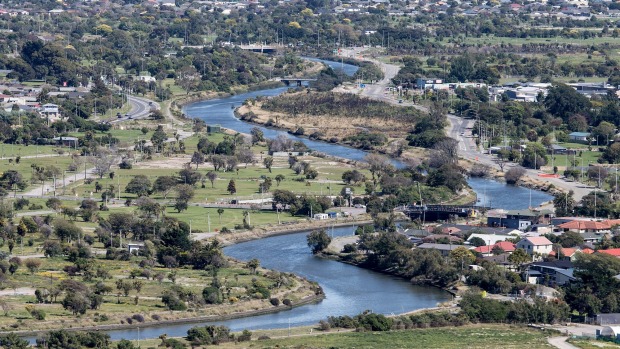
I will examine a wide range of “water stories” focused on the river — from historical documents to scientific analyses to technical reports — as well as current representations of the river in post-earthquake planning documents and journalistic accounts; conservationist, community-based, and indigenous discourse; plans for memorials and sustainable redevelopment along the river; and works of literature, film, and online media. This research will influence the crafting of my own stories of the Otakaro-Avon River and its fluid future, based on my in-the-field observations and experiences, in both narrative forms suitable for general readers as well as in scholarly prose for academic audiences — much as I have done in my recent work on the Chicago River‘s history, ecology, and future sustainability.
Key questions to be addressed in this project include but are not limited to:
- How has the Otakaro-Avon River been utilized, modified, polluted, exploited, abused, defended, etc. over time? How does the history, quality, and character of the river inform people’s relationship to its present state and future prospects?
- In what ways is the river important, economically and culturally, to the Maori indigenous people (as mahinga kai, a food-gathering place) as well as New Zealanders of European descent? How do people in Otakaro-Avon River’s watershed connect to the waterway? What kinds of activities do they undertake in terms of recreation, industry, and conservation?
- What role do the river’s conservation and restoration have in the ongoing redevelopment of Christchurch’s Red Zone and within the city’s future sustainability?
- How do the above issues intersect with questions of environmental justice, especially with respect to toxic pollution, public access to water resources and open space, and iwi (indigenous people) living with the Otakaro-Avon River watershed?
As an interdisciplinary-minded scholar within the environmental humanities, I employ a qualitative research approach. Using the analytic tools of ecocriticism, I emphasize the close reading and analysis of individual texts, their relationships with one another, and their place in the broad contexts of scientific discourse, nature writing, environmental history, and sustainability. At root, my work starts from the premises that the urban environment (both built and natural) is a worthy object of study; that natural resources are imperiled and therefore in need of protection and conservation; and that humanistic inquiry about the myriad relationships between humanity and nature in cities can foster, in the long run, ecological awareness and environmental progress.
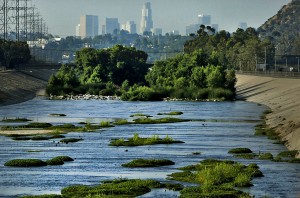
Academic and Professional Context: Urban rivers are many things simultaneously: corridors of biodiversity, green infrastructure for storm water retention, transportation arteries for commerce, waste sinks, places of human recreation, and sites of environmental restoration. This partial list illustrates their dual nature: waterways in cities are all too often heavily polluted, modified, and abused ecosystems that bear scant resemblance to their former selves. They function as receptacles of waste and servants of commerce/industry, at the expense of water quality and biodiversity; and in many cases, city dwellers are physically as well as culturally cut off from access to waterways.
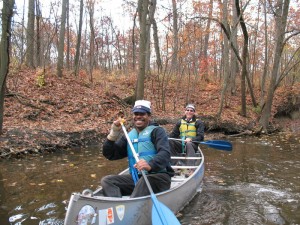
Yet urban rivers also harbor tremendous renrenga ropi (biodiversity) and exhibit a capacity to connect citizens to the natural world that exists cheek-by-jowl with the built environment as well as to their cities’ natural and cultural histories. In this sense, damaged urban water systems are pathways of connection that can foster a sense of place vital to building an environmental ethic of care among city dwellers.
Geographers, urban ecologists, environmental scientists, and sustainability scholars are assessing waterways as a critical component of urban ecosystems. Given that cities consume energy and resources from far beyond their geographic boundaries and produce high levels of waste as well as greenhouse gases, their future sustainability depends upon large-scale actions such as repairing water/wastewater infrastructure, conserving energy, improving transportation access and efficiency, enhancing biodiversity, and reducing material waste.
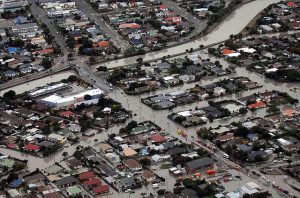
Such goals are complicated and made urgent by the destructiveness of natural disasters. The 2011 Christchurch earthquake provides a monumental challenge as well as golden opportunity for inclusive and socially just urban planning that embraces environmental sustainability as a central goal. Unsurprisingly, the Otakaro-Avon River is prominent within this planning and rebuilding process (and illustrative of its many challenges).
More broadly, urban rivers provide a specific context for assessing the impacts of global urbanization on human relationships to nature. As of 2015, over 50% of the world’s population is urban; in the US and NZ, that figure is 82% and 86%, respectively, according to the World Bank. A consequence of this is a pervasive (though hardly universal) alienation from the natural world of urban citizens. River systems constitute important natural resources where people can have direct and meaningful contact with nature close to where they live.
The stories we tell about cities and rivers are a means of grappling with the ideas and questions noted above. While the natural and social sciences generate vital empirical data on urban rivers, the role of the arts and humanities is uniquely critical to understanding urban waterways and our relationships to them. Our “water stories” are both a means of representing our values and history as well as a method of critique. The fundamental power of storytelling within human experience points to the impact of artistic expression and humanistic analysis on understanding the importance of waterways within urban ecosystems and human communities.
Significance of Study: Understanding the role of water in urban ecosystems is vital to improving the resilience of cities (e.g., protecting people and property from floods and other environmental disasters) and making them more sustainable (e.g., improving water retention and quality through expansion of green infrastructure). Cities are where most people in the world now live, a trend that will continue in coming decades as we grapple with the impacts of climate change, water quality degradation, toxic pollution, and environmental injustice. As a vital resource for all human communities, water is an important node of inquiry within environmental science and, more broadly, sustainability studies.
Urban rivers (and their watersheds, which include tributaries, wetlands, and estuaries) are ideal barometers of the ecological and socio-cultural health of our cities as well as our attitudes about and connections to the natural world. The Otakaro-Avon River is one of New Zealand’s most polluted waterways and, at the same time, one of its most important — both ecologically and symbolically — given the high number of people who live and work within its watershed and its centrality within the city’s earthquake recovery process.
Enhancing our knowledge, awareness, and appreciation of the river’s status and value is vital to its remediation and restoration as a living ecosystem that is not just an integral part of Christchurch’s green infrastructure, but also a significant thread within the city’s historical and cultural fabric. My research will explore how stories have defined the Otakaro-Avon River thus far, and how new ones might shape its sustainable future.
Why New Zealand? As an island country distinguished by highly diverse ecosystems, small and large cities, a vibrant indigenous culture, famously productive agricultural lands, longstanding conservation values, and threatened ecosystems and natural resources, New Zealand is a remarkable laboratory for exploring questions of environmental sustainability in the early 21st century.
Possessing a uniquely complex postcolonial mix of people from indigenous Maori (tangata whenua), European, and trans-Pacific Island cultures, New Zealand is progressive in its formal and structural recognition of indigenous rights, which has important implications for urban sustainable development and environmental conservation. More locally, Christchurch is a vitally important urban center: not only is it the biggest city on the South Island (pop. ~366,000), but its ongoing efforts to recover from the devastating earthquake in 2011 make it a test case for how cities can respond to natural disasters and seize opportunities to improve the sustainability of urban infrastructure, revitalize waterways, increase open space, enhance biodiversity, and involve the citizenry within the ongoing planning and reconstruction process.
Lincoln University: An incredible wealth of people and resources exist in and around Christchurch that would be invaluable to me as a scholar and writer. The Faculty of Environment, Society, and Design and its Department of Environmental Management at Lincoln University — a land-based institution located near Christchurch with a phenomenal array of environmental academic programs and research centres — offer an interdisciplinary community of scholars and teachers dedicated to environmental research and sustainability education.
LU’s Centre of Land, Environment, and People (LEaP), which is closely affiliated with the aforementioned Faculty, provides an intellectual home for research and collaboration with scholars and students from diverse disciplines spanning the natural/social sciences, the humanities, and various technical fields. Additionally, the Waterways Centre for Freshwater Management, a research collaboration between LU and the University of Canterbury, has published a wealth of technical reports on water resources throughout the Christchurch metro area and the Canterbury region, and would be an invaluable resource for advice and collaboration.
